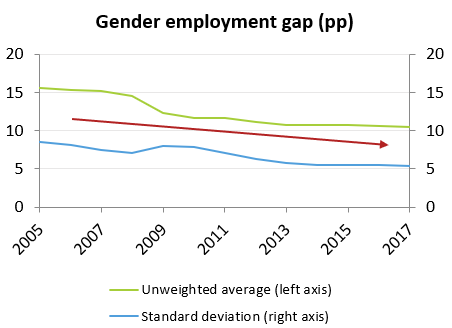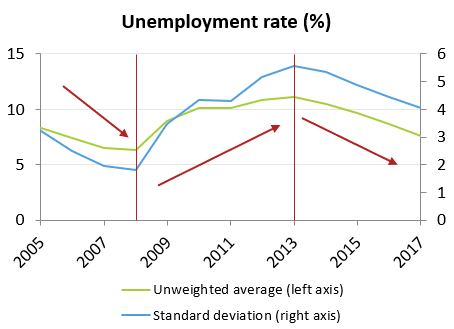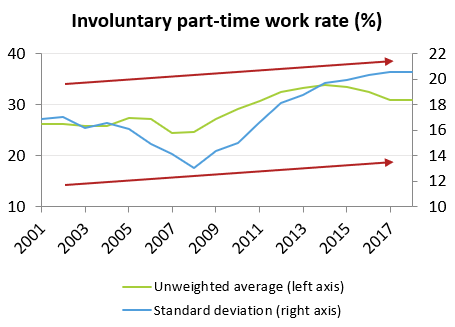The results of Eurofound’s research reveal that, despite the huge impact of the crisis, for most of the indicators considered, there is an upward convergence trend since 2005 and only a few indicators have downward trends.
While this is good news overall, the research also identifies various features of upward convergence, with some of the indicators deeply affected by the business cycle in their levels and variability.
Steady and robust upward convergence
For some indicators, upward convergence trends were steady and robust during the crisis, and in these cases the effect of the business cycle was very limited in terms of fluctuations in the average results and variability. These are: education-related indicators (early school-leavers rate and tertiary education attainment rate), gender gaps and the Eurofound job-quality indicators.

Upward convergence correlated with business cycle
Conversely, for several other outcomes, the upward convergence trends are back, but they were greatly affected by the business cycle. For these indicators, it is possible see a cyclical evolution in both averages and variability, suggesting that in good times there is upward convergence (with improvements and lower dispersion), while in bad times there is downward divergence (with deterioration in levels and higher dispersion).
The indicators greatly affected by the business cycle are:
- employment rate
- unemployment and long-term unemployment rates
- NEET rate
- poverty indicators such as at-risk-of-poverty or social exclusion (AROPE) and material deprivation
- subjective indicators such as life satisfaction and institutional trust
This rings an alarm bell, as business cycles cannot grow indefinitely and recessions are inevitable. For these indicators, Member States’ resilience should be built in order to prevent future asymmetric shocks.

Inequalities and precarisation still a problem
Downward convergence was recorded among Member States from 2005. Unfortunately, this means that Member States are more homogenous, but income inequalities are higher than 13 years ago. Furthermore, precarious attachment to the labour market has increased on average and the transition rate from temporary to permanent is lower, revealing that labour market precarisation has increased all over Europe.
So, despite the positive trends, Member States will necessarily need to take into consideration these problems in the near future.
